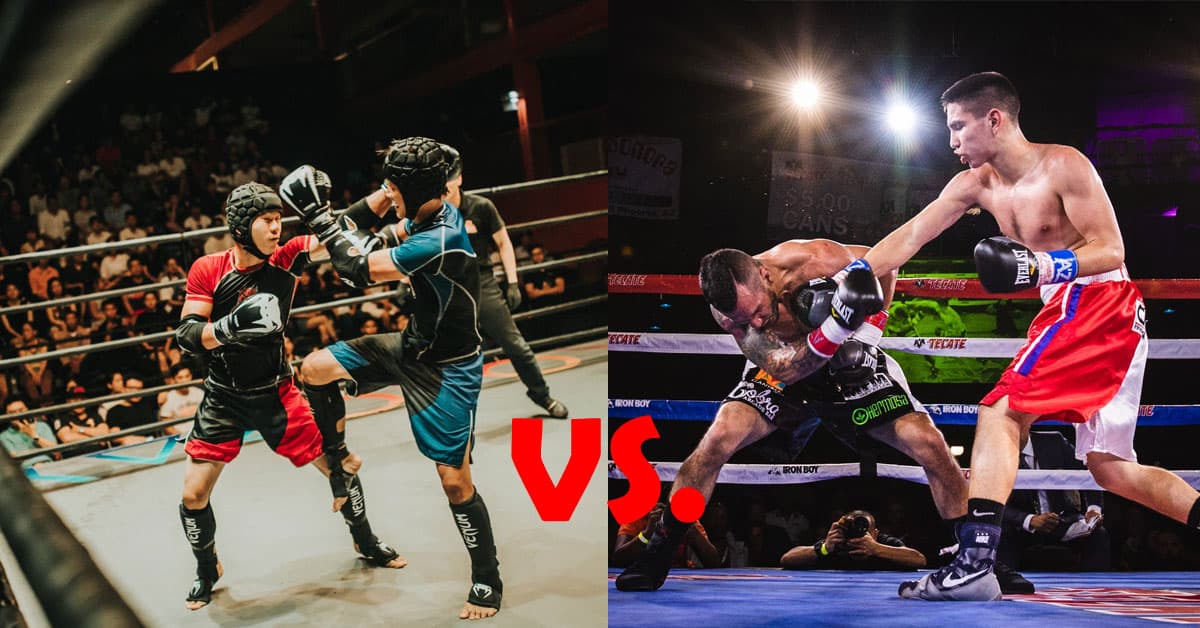When you think about striking martial arts, boxing and kickboxing are always at the top. They have much in common but are still very different from one another. So, what are the main differences between kickboxing and boxing?
The main difference between kickboxing and boxing is that boxing uses only arm techniques (punches), while kickboxing utilizes the legs (kicks) just as much as it does arms.
There is also a major discrepancy in the ruleset, technique, stance, and strategy. Also, both can be used effectively for self-defense, so even if you aren’t planning on competing in the sport, you can still benefit from training a lot. You’ll get in peak physical and mental shape, regardless of your ambitions sport-wise.
What are the differences between kickboxing and boxing?
You probably couldn’t tell the difference at first glance when looking at a boxer and a kickboxer. However, seeing only a few seconds of action is enough to determine how different these martial arts are.
The discrepancies are vast and can be spotted in several arts segments, such as technique, ruleset, movement, etc. Let’s look at each segment for a better understanding of what each sport brings to the table.
Technique differences
Since kickboxing allows kicks, while boxing does not, the technique obviously differs between the two. Kickboxers have to adjust their game to attack and defend not only punches but leg techniques as well. That means different combinations, stances, and a different approach to combat.

When it comes to punching, the method is virtually the same. Both sports use hooks, jabs, and uppercuts with some variations such as overhand punches. In kickboxing, it’s not rare to see a spinning back fist shot, while boxers hardly ever turn their backs on the opponent, not even for a split second.
Also, shots can come from different angles depending on the sport. kickboxing requires quicker movement in and out of shots, because of the larger distance a kick can reach. That enables fighters to dash inside with a kick-punch combo that boxers can’t utilize. That’s the reason you’ll see more superman punches in kickboxing.
Regarding stance, kickboxing practitioners have to learn how to defend their whole body, including the legs, whereas boxers only need to defend from the waist up. To achieve that, Kickboxers are usually lighter on their feet and use many more switches in guards, from orthodox to unorthodox and vice versa.
Movement differences
You have a much longer reach with kicks than you have with punches. Also, you have to be careful with defending low kicks in kickboxing, because only a few decent shots can limit your quickness and movement, giving your opponent a huge advantage.
Hence, the fighters will usually keep a greater distance when in guard, and use a lot of quick jabs and in-and-out moves to avoid damage. You can see movement similar to kickboxing in MMA, but it’s highlighted even more there because of the thinner gloves and the danger of being taken down.
In boxing, you have a lot less area to cover. Any strike under the waist is prohibited, and you only use your hands, so it’s a lot more difficult to penetrate through your opponent’s defense.

That’s why every successful boxer knows that, even though you can’t use kicks, footwork in boxing is probably even more important than punching. You need great evasive mobility, incredible lateral movement, and awareness of your center of balance.
Of course, that’s something you’ll benefit from in any martial art, but in boxing, it is crucial to move quickly, but smartly. You have to understand angles, how to ride both yours and your opponent’s shots, how to cut corners and prevent the opponent from escaping a trap, etc.
The complexity of the boxing movement is incredible, which is why many say boxing is a science, not merely a fight sport. You have to learn how to move your feet, how to maintain your defense even when going inside on the attack, and there is a big emphasis on head movement.
Rules differences
The first and the obvious – kickboxing allows leg striking, while boxing does not. But, there is more to it. For instance, some versions of kickboxing also allow elbow strikes, while those are strictly prohibited in boxing.
In boxing, the bouts are usually set to eight, ten, or twelve rounds, lasting three minutes each. You automatically win if you knock your opponent out, or if you knock him down enough times for the match to be stopped. It’s usually three times in the same round or four times during the course of the match.
If none of the fighters manages to do so by the end of the last round, the fight goes to the judges who score each round and declaring the winner in the end.
It’s almost the same in kickboxing, except the fights are most commonly set to 3 or 5 rounds. Also, clinches are separated a bit quicker in kickboxing, and more action is required. If the fighters show passivity, they will be warned and penalized quickly.
Other than that, and the rules connected with striking (using legs, etc.), the rest of the game is pretty similar. Both are conducted in a square ring, with big padded gloves and shorts. Mouthguards are mandatory, as well as wrist bandages.
An element that distinguishes gear requirements though, is the headgear – critical for the kickboxer’s safety. For the clueless or eager to upgrade their gear, this has got to be the most comprehensive resource for the Best Kickboxing Headgear in the market.
The only difference in equipment is in footwear. Boxers usually wear boxing boots or shoes, while Kickboxers fight barefoot, or with elastic bandages to support ankles.
Which is better for self-defense: kickboxing or boxing?
It is safe to say that there is no striker more profound than a skilled boxer. In boxing, you are taught how to work both offensively and defensively, and the striking is pure art. That being said, the lack of leg strikes and kick defense makes it a bit tougher to defend yourself only with boxing in a street fight or an assault.
That’s why kickboxing is a bit more efficient for self-defense. You’ll learn how to block and evade kicks, but you also learn the basics of takedown defense, which will enable you to avoid getting tossed to the ground.
To add to it, a wider skill set that enables the use of both legs and arms is highly effective if you are attacked by multiple attackers at once, too.
B boxing relies more on strategy and patience, which can be a problem when attacked unexpectedly outside the ring. You won’t have time to prepare your game and strategize. However, that doesn’t mean it is also ineffective for self-defense.
On the contrary, boxers have a high IQ when reading the opponent and predicting his next move. That will allow you to patiently wait for the attack and then react powerfully and precisely, instead of swinging wildly in hopes to get away with a shot.
In the end, both have advantages and disadvantages when it comes to self-defense, but the biggest difference-maker is the ability to use both your arms and legs in kickboxing, while you’re limited only to punching with boxing.
We can safely say that the art of boxing is much more effective in a ring than it is in a street fight with no set rules.
Which one should you choose: kickboxing or boxing?
If you want to learn how to defend yourself, then you should go with kickboxing. Not because it’s better, but because it will teach you more diverse striking methods, allowing you to defend yourself against a greater variety of attacks.

To maximize your self-defense abilities and increase your chance of success in the world of kickboxing, don’t forget to check out the top-rated gear, as Kickboxing Gloves, to provide the optimal protection and performance you need.
B boxing can do that for you, too, but it works much better as a regulated sport than a self-defense method.
Another factor you must consider when choosing between the two is your preference and tolerance towards taking damage. kickboxing can be extremely brutal, and it doesn’t allow you to focus only on one part of your body when bulking up. You must work on your lower body strength just as much as your upper body.
Boxers tend to focus more on their upper body and disregard leg training to a certain degree, simply because they don’t need to use kicks in combat. So, if your motivation is to become successful in any of the sports, make sure you know what you’re getting into before stepping into the ring.
Finally, if your motivation is only recreational, both of these martial arts are great. They will get you in pristine physical condition – make sure you don’t skip leg day. The nature of these arts enables you to build endurance, strength, and stamina.
But, it doesn’t stop with the physical. It will also help you get a lot tougher mentally, and improve your focus, determination, and patience – all of which are great traits that can translate to everyday life, too.
So, in kickboxing vs boxing choice, you should choose one or the other based on your preferences and abilities.
If you only want to learn self-defense and strength is your strong side, try kickboxing out. But, if you are more of a strategist who’d take technique and skill over power, then boxing is the way to go for you.
Both boxing and kickboxing can get the job done, but at the end of the day, you are the only person who knows which combat sport is perfect!
Everything you need to know about boxing VS kikboxing
Q: What is the difference between boxing and kickboxing?
A: Boxing and kickboxing are both forms of martial arts, but they focus on different skills. Boxing focuses mainly on hand techniques, balance, and footwork, whereas kickboxing incorporates kicks, elbows, and knee strikes. There’s also a significant difference between kickboxing and boxing regarding rules. In boxing, blows to the opponent’s head and upper body are allowed, while kickboxing uses various techniques.
Q: Would an MMA fighter trained in Boxing or Kickboxing have an advantage?
A: This largely depends on the individual’s skills and strategy during a match. Boxing can provide valuable skills in footwork and punching, while kickboxing also offers kicking and knee strike skills. Ultimately, in a mixed martial art like UFC, the one who is more versatile and better prepared would have the upper hand.
Q: Which martial art is better to learn, boxing or kickboxing?
A: Both boxing and kickboxing have their strengths. Learning boxing first can provide a solid foundation in footwork and striking techniques, which can be very beneficial later on when learning kicks. On the other hand, kickboxing may provide a broader set of skills from the start. It largely depends on your interest, fitness level, and personal goals.
Q: Why would a person learn boxing over kickboxing and vice versa?
A: This would depend on their personal goals. Kickboxing may be a better fit if they are looking for a full-body workout and to learn various techniques. Boxing is often chosen for its focus on precision, footwork, and high-intensity training. Practicing boxing also helps to improve balance, coordination, and cardio fitness.
Q: How does the sport’s history differ between boxing and kickboxing?
A: Boxers have been around for centuries, tracing their roots back to ancient Greece. Kickboxing, on the other hand, is a much newer sport. It originated in the 1960s when Japanese karate experts adapted muay Thai techniques into their practices to compete against muay Thai fighters.
Q: What is the key difference between Karate and Kickboxing?
A: Karate is a traditional martial art involving kata (formal exercises) and emphasizes self-defense with many techniques aimed at disabling the opponent. Kickboxing, on the other hand, focuses more on strike fighting and is often utilized in competitive platforms like kickboxing matches and MMA/UFC fights. Although both involve striking, the techniques and philosophies differ greatly.
Q: What are the cons of kickboxing compared to boxing?
A: Kickboxing involves moves that could lead to more injuries, such as knee and ankle strains from improperly landed kicks. It might also be physically demanding, requiring greater flexibility and coordination. As for boxing, the cons may include more concentrated blows to the head, and it lacks the kicking component for those interested in a more diverse skillset.
Q: Do the boxing workouts provide better cardio than kickboxing workouts?
A: Both sports can provide excellent cardio workouts. However, kickboxing is often considered a fuller body workout due to the variety of kicks and knee strikes. At the same time, boxing workouts are more upper-body focused. It’s also worth noting that both forms of training can help develop endurance and cardiovascular health.
Q: How do Thai boxers or Muay Thai fighters perform compared to Boxing or Kickboxing?
A: Muay Thai fighters might perform differently because they incorporate fists, elbows, knees, and leg strikes, making them versatile in attack and defense. They also practice different clinching techniques. However, pure boxing provides advanced hand striking and footwork specific to boxing matches, and kickboxers have a balance between the two, depending typically on whether it’s American kickboxing (which resembles more boxing) or Japanese (which includes leg kicks)
Q: Can I spar in boxing and kickboxing with the same partner?
A: The answer depends on how much experience your partner has in both sports. If she or he is proficient in both, it’s beneficial to spar in boxing and kickboxing with the same partner. You both can guide each other in improving in these two different martial arts. However, always ensure safety first and follow set rules when sparring.

